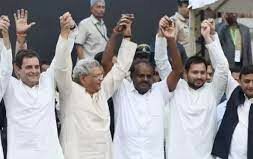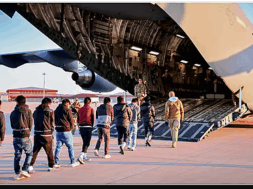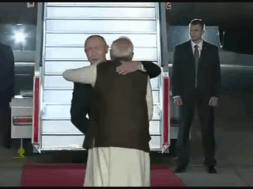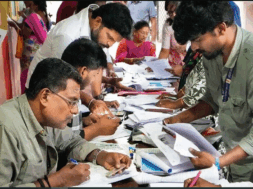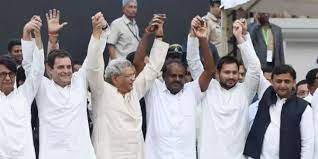
Manas Dasgupta
NEW DELHI, June 21: With the first tiny step they are scheduled to take on Friday, an uphill task is ahead the opposition parties and its prime mover, the Bihar chief minister Nitish Kumar to bring the frequently warring and often contradictory forces together on one platform to fight “one on one” against the ruling BJP in the coming Parliamentary elections.
Though almost all the opposition parties agree that the best option to oust the BJP from power at the centre would be avoid division of anti-BJP votes among multiple candidates, the local conditions, personal ego of the leaders and the fear of losing grounds to other parties are likely to become stumbling block in bringing them together.
The opposition leaders are scheduled to hold their first meeting on Friday in Patna on their way to bring the non-BJP parties on one platform. From social justice to the alleged misuse of investigating agencies by the Centre to violence in Manipur, the wrestlers’ protest and even the Delhi ordinance, several issues are likely to be discussed in the opposition meeting but even deciding the priority on the line of discussion could become a matter of dispute.
The Delhi chief minister Arvind Kejriwal on Wednesday wrote a letter to all opposition parties demanding that the Central ordinance on the Delhi services control order, which at the moment affect only the Delhi government, should be give the first priority in the June 23 conclave of the opposition parties. He also threatened that if the opposition parties did not give the issue the highest priority and finalise strategy to defeat the ordinance-replacing bill in the Rajya Sabha, “a day will not be very far when Prime Minister Narendra Modi will issue similar ordinances to control directly all the non-BJP states through his appointed governors and lieutenant governors.” It is doubtful, if most other opposition parties will consider the issue to be the most urgent to taken up the first item for discussion.
Bihar Chief Minister Nitish Kumar, who is looking at a Jayaprakash Narayan (JP)-like role for himself, is set to play host to opposition parties. Patna and the JP movement was instrumental in challenging the might of former Prime Minister Indira Gandhi in 1974, and the West Bengal chief minister Mamata Banerjee had suggested to Nitish Kumar to take yet another initiative from Patna to challenge the might of Modi in 2024.
But this is just the first step towards what can result in some joint opposition to the BJP which scored 303 Lok Sabha seats in 2019 — 21 more than in 2014. It won’t be easy for the opposition to provide a strong counter to that unless it comes up with a clear-cut “one seat one candidate” formula in as many seats as possible.
This is also the first-time parties like the Trinamool Congress, Samajwadi Party, and Aam Aadmi Party (AAP) – hostile towards the Congress – will share a common platform with the party. That reflects the importance of the meeting. There will be no common minimum programme in this meeting; only plans will be discussed, opposition sources said indicating that a common statement was likely.
Before the opposition can come together, a number of stumbling blocks would have to be addressed before the final picture emerges. With the emergence of Modi, the Lok Sabha elections in the country have particularly become personality-driven. Against the BJP’s projection of Modi as a decisive leader, with strong national security credentials and a raft of welfare schemes with a large beneficiary base cutting across caste lines, many non-BJP parties feel a strong leader to rally around would give the opposition a certain direction. But with leaders such as Rahul Gandhi and Mallikarjun Kharge in the Congress, Sharad Pawar in the NCP, Mamata Banerjee in Trinamool Congress, Nitish Kumar, KC Rao in Telangana and many others, it won’t be easy for the opposition to pick a name.
In just the Hindi heartland in 2019, the BJP under Modi won 141 seats — which was 71 per cent of the seats it contested — with more than a 50% vote share. In many states, leaders such as Yogi Adityanath, Siddaramaiah, Himanta Biswa Sarma and Mamata Banerjee have been able to create voter bases centred around their own politics, which only proves the importance of a strong leader in Indian politics.
The contradictions between various opposition parties are not easily wished away. Among recent challenges is the ordinance passed by the Centre, taking away most of the Delhi government’s powers. While AAP wants other opposition parties to support it, the Congress leadership is treading cautiously. The Congress was also late to condemn the alleged high-handedness of the investigating agencies when it came to the arrest of AAP leader Manish Sisodia. The politics around Hindutva ideologue Veer Savarkar is another issue, with Congress, specifically Rahul Gandhi, often picking on it and landing the Uddhav Thackeray-led Shiv Sena in a spot.
Even in issues such as the Ram Temple, many opposition parties differed from the rest. Being wary of losing their Hindu voters in the face of an aggressive BJP, some have gone slow on issues related to minorities, and even on the issue of the Uniform Civil Code. While it is clear the protection of constitutional values, federalism and secularism will be fundamental to the united opposition’s common strategy, it won’t be easy for parties to come up with a programme that represents all their interests equally.
The Trinamool (TMC), Congress, AAP, Samajwadi and others have often fought each other and in different states. It won’t be easy driving a cordial relationship among them. Last year, when Mamata Banerjee convened a meeting of opposition parties to build consensus on a joint candidate for the Presidential elections, she found only limited support from the Congress. There are also electoral rivalries. Just recently, three months after the Congress won its first MLA from Sagardighi Assembly seat in a bypoll, the TMC poached the lawmaker, Bayron Biswas, on Monday, leading to more words of discord between the Congress and TMC.
The loss of Sagardighi was a big setback for the TMC, casting doubt on the belief that the party is preferred by Muslims. AAP has grown largely at the cost of the Congress, which often dubs it the BJP’s B-team. The Samajwadi Party too has called its alliance with the Congress in the past a bad experience, which is why it’s not going to be easy to get regional parties to make adjustments and give space to the Congress.
Delhi and West Bengal are being seen as the biggest challenges for opposition unity, given the history of friction between the Congress, TMC and AAP. It remains to be seen how seat-sharing arrangements take place in states such as Jharkhand, Kerala, and Uttar Pradesh, where several opposition parties have high stakes. Together, these states account for 130 Lok Sabha seats. What happens in states like Odisha and Andhra Pradesh, where parties like the YSR Congress Party (YSRCP) and BJD have largely decided to remain equidistant from the Congress and the BJP, will also be interesting.
The Congress believes it should rightfully be the pivot of opposition unity efforts, given that it is the largest among the parties and thinks of itself as the only national alternative to the BJP. Its victory in Karnataka has only strengthened the party’s aspirations. However, the difficult task of convincing the other parties has been left to Nitish Kumar, which is why he is emerging as the fulcrum of the opposition.
The Congress too would be reminded that in 2019, in 20 states and Union Territories, the Congress didn’t win a single seat and had a double-digit tally in just one state, Kerala, while in 224 seats the BJP’s vote share exceeded 50 per cent compared to 136 in 2014.
